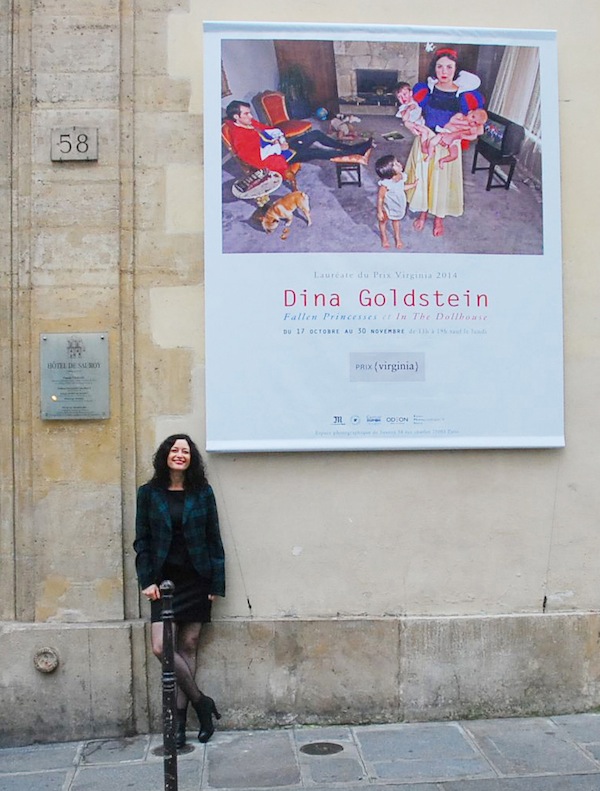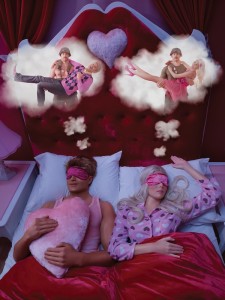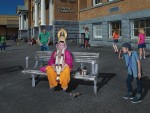“Ganesha,” from Dina Goldstein’s Gods of Suburbia series. (photo © Dina Goldstein)
You have to speak more than one language if you want to read all of the articles on Vancouver photographer and Pop Surrealist Dina Goldstein’s art. English, of course, but also French, Italian, Spanish and Greek, for starters. Among other places, her work has been exhibited in Canada, of course, but also Poland, India, Colombia and, most recently, Holland.
She attended the Oct. 11 opening of In the Dollhouse at Rize Gallery in Amsterdam. “I try to get to all of my openings,” she told the Independent in an email interview. “Traveling and experiencing other cultures is the perk of being an artist. I enjoy being at the exhibition in person and seeing the reactions to my work. The galleries also like it when the artist is there to offer more perspective.”
In the Dollhouse is the second of three large-scale photographic series that Goldstein has created. The other two are Fallen Princesses and Gods of Suburbia. All three have been, or are being, exhibited in various places. About whether galleries pay artists to display their work, Goldstein explained, “The agreements vary from gallery to gallery, sales from the show are split between the gallery and the artist. There are some festivals that cover travel and accommodation in order for the artist to attend. I currently produce my own large-scale projects with the help of print sales and grant awards. These are print sales of my limited edition pieces from Fallen Princesses, In the Dollhouse and the Gods of Suburbia series (displayed on LED light panels).
“There are also art competitions that award cash prizes. This was the case for me when I won the Prix Virginia in 2014 and was gifted 10,000 euros.”

Goldstein has been a photographer for 25 years. “I started out quite young and worked very hard in my 20s and 30s to create a career for myself,” she said. “I was a photojournalist and traveled to war-torn regions. I freelanced, shooting covers and feature stories for magazines. (I was a staff photographer at the Jewish Western Bulletin.) I also photographed some cheeky ads with some brilliant art directors. People within the Vancouver Jewish community will remember me photographing weddings and bar mitzvahs; alongside, I created my own projects. Usually concentrated on the study of sub-cultures within society, I termed the work ‘photoanthropology.’ These images were documentary, photojournalistic.
“In 2009, I released my tableau series Fallen Princesses, which was an internet success and brought recognition to my personal work. I went on to realize more ambitious projects like In the Dollhouse in 2012, and Gods of Suburbia in 2014. I am now fully concentrated on producing my own large-scale conceptual series and have become a full-time artist.
“Storytelling has always been central in all of my work past and present,” she continued. “Documentary photography allowed me to create and share the stories of Palestinians in Gaza, gamblers at the racetrack, East Indian blueberry farmers in B.C., dog show dogs, bodybuilding state championships and teenagers dirty dancing at a bar mitzvah.”
Readers can see many of those images at dinagoldstein.com. They can also see images of her three large-scale series, all of which challenge viewers to question their beliefs, some of which were instilled in childhood. Is there an ideal body, an ideal marriage, an ideal anything? Can we rest assured that good ultimately prevails and evil is punished?
“Much of my work investigates the myth of perfection and the collective perception influenced by pop culture,” said Goldstein. “Western society today is influenced by pop culture, which informs us how to look, what to like, what to buy. Most people don’t even realize the effects of the unconscious collective that drives us to behave in certain ways. Perfection is not stable or sustainable in nature and in life. Also, there is an individual perspective about what is ‘good’ or ‘perfect.’ This is mainly the reason that I work with archetypes and stereotypes to relay my messages and offer some social critique. By twisting the storylines of beloved characters, I am able to provide some insight into the human condition, and expose the many flaws in the nature of humankind.”
Fallen Princesses takes the Disney version of 10 fairy-tale women, including Snow White, Sleeping Beauty, Jasmine and others, and “creates metaphor out of the myths of fairy tales, forcing the viewer to contemplate real life: failed dreams, addiction, obesity, cancer, the extinction of indigenous culture, pollution, war and the fallacy of chasing eternal youth,” reads the description on Goldstein’s website. Goldstein’s Snowy, for example, is pictured in an unkempt living room, holding two kids in her arms, with one child pulling on her skirt and yet another playing on the floor, where a dog eats potato chips that her beer-drinking, TV-watching prince has let fall.

In the Dollhouse also features an iconic couple long into their marriage: Barbie and Ken. In Goldstein’s version, Ken begins to understand and accept his homosexuality, and he seems to flourish as the narrative progresses, while Barbie “breaks down and confronts her own value and fleeting relevance.”
But why doesn’t Barbie take her dream car and leave Ken? And the princesses? Granted they likely haven’t been taught the life skills needed to deal with illness, raising a family, etc., but do they just accept their unhappily ever after, or do they rail against it? Are they victims or survivors, both or neither?
“Throughout history, the focus in storytelling has been on men and their outlook of this world,” said Goldstein. “Women’s desires and interests have mostly been marginalized. I feel lucky to live in a free Western society where women’s roles are now more prominent. As a woman experiencing this transformation, I take full advantage by creating art that fully expresses my thoughts and opinions. I create art with fictional characters that has elements of real life. What you see within a work is a moment in time (within the fictional life or these fictional characters). As Barry Dumka pointed out in his essay, yes,
Barbie has lost her head, but she is Barbie and that head can pop right back on. Unfortunately, humans don’t have that luxury. In my tableau, the princesses are thrust into everyday life within realistic environments. They, too, have to figure out how to function and thrive within a complex world.”
Goldstein’s website is fascinating. Not only is her artwork displayed there and her many interviews, but she has a section called Dig Deeper. There, visitors can spend hours reading intelligent, thoughtful analyses of her work, including the aforementioned essay by Dumka.
Despite the grim situation of the princesses, of Barbie, there is humor in Goldstein’s work – there’s something sardonic about seeing Ariel, the Little Mermaid, in an aquarium, Belle of Beauty and the Beast undergoing plastic surgery, or Ken wearing Barbie’s high heels, for example. In Gods of Suburbia, she portrays Satan as a tow-truck operator, Darwin is watching people play the slots at a casino, and Buddha is shopping at Wholey Foods.
“I try to keep everything in perspective,” said Goldstein. “Let’s face it, life can get overwhelming and too serious. I use humor to cope with all that the world throws at me. Also to create conversation about modern society and how we perceive it. I utilize satire, which is intelligent ridicule, and irony, because it creates a situation that differs radically from what is actually the case.”
In a Times of Israel interview, when asked if there was a particular God of Suburbia that moved her most, Goldstein said Ganesha.
“The Ganesha piece was inspired by personal memories,” she told the Independent. “My family moved from Israel to Canada in 1976. At that time, Vancouver was a small town and it had not yet experienced the mass Asian population that you see today. My first few years here were very difficult and, as a young child, it was hard to comprehend.
“Learning a new language whilst dealing with schoolyard bullies. Even in high school, and after many years of integration, I felt different somehow. Most of my family remained in Israel, so we would visit every couple of years for the whole summer. There, I got recharged with chutzpah and the realities of war. So, I became an Israeli/Canadian hybrid. Israeli in many ways and not the typical Canadian. However, these days I know that I’m fully Canadianized because I listen to the CBC radio all day!
“Ganesha is naturally odd, as he has an elephant head and a boy’s body. He is different because of his appearance (I didn’t have that problem) but also because of his unique culture. He is judged for how he dresses, what he eats and even what he believes in. He faces the same cruelty that I encountered in elementary school.”
While all of Goldstein’s art can be seen on her website, there is nothing that can compare to seeing it in person. Gods of Suburbia will travel to Montreal in February to be shown by Art Souterrain. And there also will be at least one local opportunity to see the exhibit next year.
“The Diamond Foundation has generously donated the whole Gods of Suburbia show to appear at the Capture Festival [in April],” said Goldstein. “The exhibition will take place at a new gallery on East 6th Avenue in Vancouver called SOMA.”

